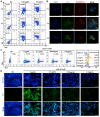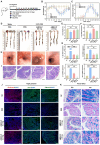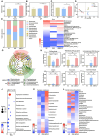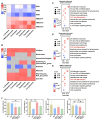Atractylodes macrocephala-derived extracellular vesicles-like particles enhance the recovery of ulcerative colitis by remodeling intestinal microecological balance
- PMID: 40490795
- PMCID: PMC12150547
- DOI: 10.1186/s12951-025-03506-8
Atractylodes macrocephala-derived extracellular vesicles-like particles enhance the recovery of ulcerative colitis by remodeling intestinal microecological balance
Abstract
Current treatment of ulcerative colitis (UC) remains challenging, with the mainstay of therapy being 5-aminosalicylic acid-based drugs, which have limited and inconsistent results. Atractylodes macrocephala (AM) is a traditional Chinese medicine commonly used in the clinical treatment of various inflammatory diseases. Herein, we demonstrate that AM-derived extracellular vesicle-like particles (AMEVLP) can effectively modulate the gut microbiota, thereby significantly improving the treatment efficiency of UC. This is achieved by enhancing the alpha diversity of the gut microbiota and re-establishing beneficial types, which in turn alter tryptophan metabolism, leading to an increase in indole derivatives within the gut. This process also protects the gut barrier and exerts anti-inflammatory effects. The mechanism behind these anti-inflammatory effects is closely associated with the Th17 cell differentiation signaling pathway. It is believed that the AMEVLP enable them to efficiently remodel gut microbiota, providing an avenue for the treatment of various inflammatory diseases. Significantly, preliminary clinical trials have shown that AMEVLP can substantially slow the progression of the disease in UC patients.
Keywords: Atractylodes macrocephala; Extracellular vesicle-like particles; Inflammation; Intestinal microecological; Ulcerative colitis.
© 2025. The Author(s).
Conflict of interest statement
Declarations. Competing interests: The authors declare no competing interests.
Figures







References
MeSH terms
Substances
Grants and funding
- QT20230101268/Young Talent Support Project of Guangzhou Association for Science and Technology
- 202201009 and 20230710/Science and Technology Projects in Liwan District, Guangzhou
- 2022ZDZX2016/Special focus areas for general universities in Guangdong Province
- 82174119/the National Natural Science Foundation of China
LinkOut - more resources
Full Text Sources
Medical

